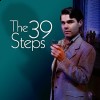In the monologue with which the stage version of The 39 Steps begins, our hero, Richard Hannay (Jim Sorensen), declares himself bored with the world in general and his life in particular. To cheer himself up, he believes, he needs “something mindless and trivial. Something utterly pointless.” It doesn’t take him long to bolt out of his armchair and declare, “I know! I’ll go to the theater!”
If you’re feeling like Hannay in any way, this first-rate Flat Rock Playhouse production fits the bill. Originally conceived as a showcase for performers, what is known as Alfred Hitchcock’s The 39 Steps in New York (where the award-winning show has played three different Broadway houses since 2008 and continues today Off Broadway) and as James Buchan’s The 39 Steps in London (where it premiered and won the 2007 Olivier Award for best new comedy) has absolutely nothing on its mind but entertainment and plenty of it.
With outstanding work by Sorensen in the lead, Erin Mosher playing three major female characters, the preposterously funny duo of Charles McIver and Scott Treadway playing all the other roles (perhaps not the 150+ claimed but certainly dozens), agile direction by Don Stephenson, and dazzling work by the entire design team, Flat Rock’s The 39 Steps makes the company’s previous lightweight endeavor, The Producers, seem like a doctoral dissertation on the psychology of human lust and greed. If frivolity is what you’re after, The 39 Steps delivers.
No need to know anything about Buchan’s 1915 novel, from which this show draws very little. Familiarity with the revered Hitchcock thriller of 1935, which dispensed with much of the original, anyway, isn’t necessary either, though it could add to the fun since most of what transpires onstage is a scene-by-scene, line-by-line recreation of the film. This isn’t parody, precisely, and it’s certainly not satire.
Instead, it’s a genial, nod-and- wink appreciation of the movie (which frequently has its own tongue planted firmly in its own cheek, and is itself the source of much of the humor here) as well as a paean to the stage, the secrets of which are frequently displayed with fourth-wall dispatching glee.
The plot, such as it is, serves the play as what Hitchcock termed the MacGuffin — the meaningless bit of business that sets everything in motion. Hannay goes to a music hall where, while Mr. Memory (McIver) performs his fantastic feats of fact recollection, a shot rings out. Soon Annabella Schmidt (Mosher) is in Hannay’s arms, asking him to take her home. Though sex seems what she intends, it isn’t; Annabella is a spy for hire, trying to keep a military secret from being spirited out of England. But before the night is through, Annabella expires, due to a knife in her back (and some amusing physical business exclusive to the stage).
Seeking a man in Scotland Annabella needed to see — and pursued as the chief suspect in Annabella’s murder — Hannay escapes on a train; eludes the police by throwing himself into the arms of Pamela (Mosher), who betrays him; jumps from a bridge; hides in the farmhouse of the overly religious John (McIver, in a truly demented turn), who betrays him, and of John’s wife Margaret (Mosher), who loves and helps him; flees through the countryside; finds the man, with turns out to be the wrong man (Treadway, in another truly demented turn); gets arrested but escapes again; is mistaken for a politician and forced to improvise a speech, during which Pamela reappears and betrays him a second time; gets picked up by the bad guys (McIver and Treadway) pretending to be police; gets handcuffed to Pamela with whom he manages to make a getaway; spends a night in a hotel still handcuffed to Pamela, until she slips out of the cuffs and accidentally learns that Hannay’s been telling the truth all along; and ends up at the London Palladium, where Mr. Memory performs, the secret of “the 39 steps” is revealed, and all ends … well, let’s not say happily. Let’s just say it ends.
Along the way, the actors, director, and designers combine to create marvelous, mirthful effects from minimal elements: the boxes the performers magically transform into a train; several scenes in which imaginary wind plays a major role; and, perhaps above all, a shadow puppet sequence that pays homage to Hitchcock’s North by Northwest (just as any number of musical snippets reference Hitchcock movies, the titles of some of which get slipped into the dialogue).
Though the invention flags somewhat after intermission, there’s fun throughout, and the actors make the most of their opportunities. Watch the handcuffed Sorensen and Mosher negotiate a fence or remove Mosher’s stockings. Enjoy McIver and Treadway in all of their roles, male and female, and the quick changes frequently made without leaving the stage.
If you like your comedy with bite, The 39 Steps may not be for you. But when it comes to light summer froth, Flat Rock has done it again, with style and flair.
The 39 Steps, adapted by Patrick Barlow from the novel by John Buchan, the movie by Alfred Hitchcock, and an original concept by Simon Corble and Nobby Dimon. Directed by Don Stephenson. Scenic Design by James W. Johnson. Costume Design by Janine Marie McCabe. Lighting Design by Stephen Terry. Sound Design by Allen Sanders. Casting Director and Artistic Consultant: Dave Clemmons. Properties Master: Paul Feraldi. Technical Director: Bruce R. Bailey. Stage Manager: Johanna M. Erlenbach. With Jim Sorensen (Richard Hannay), Charles McIver (Man #1), Scott Treadway (Man #2), and Erin Mosher (Annabella Schmidt, Pamela, Margaret).
Through Sept. 12 at Flat Rock Playhouse.






Dramaturg, I dedicate the 7th graf to you.
Is Steven Samuels really a pen name for Molly Bloom?